工程力学知识点(英文)
力学词汇(mechanics)
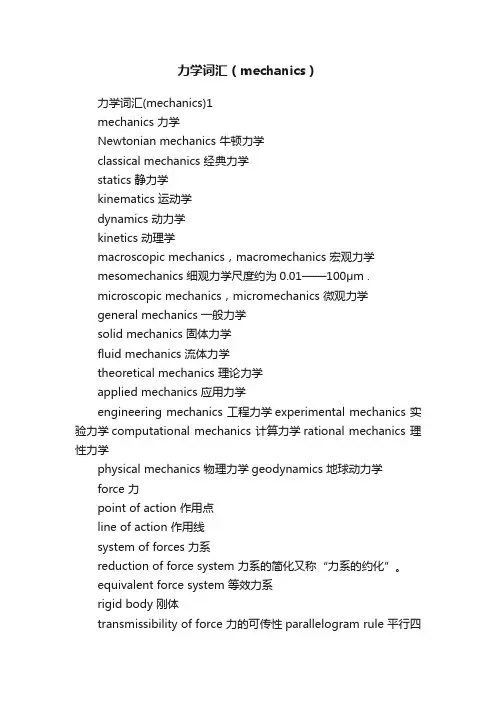
力学词汇(mechanics)力学词汇(mechanics)1mechanics 力学Newtonian mechanics 牛顿力学classical mechanics 经典力学statics 静力学kinematics 运动学dynamics 动力学kinetics 动理学macroscopic mechanics,macromechanics 宏观力学mesomechanics 细观力学尺度约为0.01——100μm .microscopic mechanics,micromechanics 微观力学general mechanics 一般力学solid mechanics 固体力学fluid mechanics 流体力学theoretical mechanics 理论力学applied mechanics 应用力学engineering mechanics 工程力学experimental mechanics 实验力学computational mechanics 计算力学rational mechanics 理性力学physical mechanics 物理力学geodynamics 地球动力学force 力point of action 作用点line of action 作用线system of forces 力系reduction of force system 力系的简化又称“力系的约化”。
equivalent force system 等效力系rigid body 刚体transmissibility of force 力的可传性parallelogram rule 平行四边形定则force triangle 力三角形force polygon 力多边形null-force system 零力系equilibrium 平衡equilibrium of forces 力的平衡equilibrium condition 平衡条件equilibrium position 平衡位置equilibrium state 平衡态component force 分力resultant force 合力resolution of force 力的分解composition of forces 力的合成couple 力偶arm of couple 力偶臂system of couples 力偶系resultant couple 合力偶moment arm of force 力臂moment of force 力矩moment of couple 力偶矩moment of area 面矩center of moment 矩心moment vector 矩矢moment vector of couple 力偶矩矢principal vector 主矢principal moment 主矩torque 转矩force screw 力螺旋acting force 作用力reacting force 反作用力reaction at support 支座反力friction force 摩擦力kinetic friction 动摩擦rolling friction 滚动摩擦coefficient of rolling friction 滚动摩擦系数sliding friction 滑动摩擦coefficient of sliding friction 滑动摩擦系数static friction 静摩擦coefficient of maximum static friction 最大静摩擦系数angle of friction 摩擦角Coulomb law of friction 库仑摩擦定律center of reduction 简化中心又称“约化中心”。
工程力学全英文Engineering Mechanics (2)
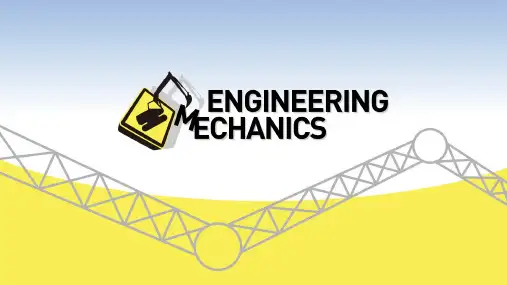
Fundamental Concepts and Principles of Statics
Fundamental Concepts of Statics
Force is the mechanical interaction between bodies that changes or tends to change the motion state or the shape of the body on which it acts.
opposite senses. Fifth Principle (Principle of Solidification)
C
The system will
move.
F If a freely deformable body (or body system)
subjected to the action of a force system is in M
without
changing
its
external
effect
on
a
rigid
body.
(Forces
are
sliding
vectors)
F
F F' F F
F
A
B
A
=
B
=
A
B
Fundamental Concepts and Principles of Statics
Third Principle (Principle of Force Parallelogram)
Fundamental Concepts and Principles of Statics
力学专业 英语词汇

专业英语第一节一般术语1. 工程结构building and civil engineering structures房屋建筑和土木工程的建筑物、构筑物及其相关组成部分的总称。
2. 工程结构设计design of building and civil engineering structures在工程结构的可靠与经济、适用与美观之间,选择一种最佳的合理的平衡,使所建造的结构能满足各种预定功能要求。
3. 房屋建筑工程building engineering一般称建筑工程,为新建、改建或扩建房屋建筑物和附属构筑物所进行的勘察、规划、设计、施工、安装和维护等各项技术工作和完成的工程实体。
4. 土木工程civil engineering除房屋建筑外,为新建、改建或扩建各类工程的建筑物、构筑物和相关配套设施等所进行的勘察、规划、设计、施工、安装和维护等各项技术工作和完成的工程实体。
5. 公路工程highway engineering为新建或改建各级公路和相关配套设施等而进行的勘察、规划、设计、施工、安装和维护等各项技术工作和完成的工程实体。
6. 铁路工程railway engineering为新建或改建铁路和相关配套设施等所进行的勘察、规划、设计、施工、安装和维护等各项技术工作和完成的工程实体。
7. 港口与航道工程port ( harbour ) and waterway engineering为新建或改建港口与航道和相关配套设施等所进行的勘察、规划、设计、施工、安装和维护等各项技术工作和完成的工程实体。
8. 水利工程hydraulic engineering为修建治理水患、开发利用水资源的各项建筑物、构筑物和相关配设施等所进行的勘察、规划、设计、施工、安装和维护等各项技术工作和完成的工程实体。
9. 水利发电工程(水电工程)hydraulic and hydroelectric engineering以利用水能发电为主要任务的水利工程。
工程力学全英文Engineering Mechanics (30)
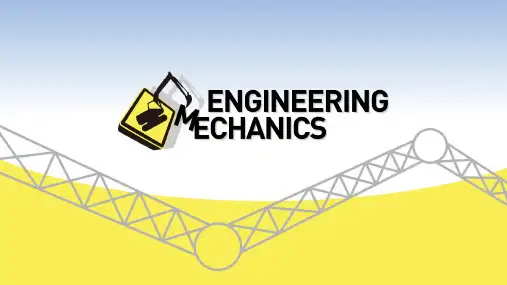
12
The Procedure of Analysis
to determine the relative displacement between two points A and B on axially loaded member 1. Internal Force
The method of sections; How to determine the location of the section?
Part II: Mechanics of Materials
Axial load
AXIAL LOAD
Average normal stress in axial loaded member
• The localization of the stress distribution
• The deformation of the axial loaded member • Analysis of indeterminate axial load member • Analysis of thermal stress and stress concentration • The stress on the inclined surface of an axial loaded member
If the force varies continuously along the member’s length, arbitrary location and P(x); If several constant external forces, each segment between any two external forces
AB 0
Since the end supports are fixed. Thus relative displacement of one end of the bar with respect to the other end to be equal to zero
工程力学英文版课件03 Nonconcurrent Forces
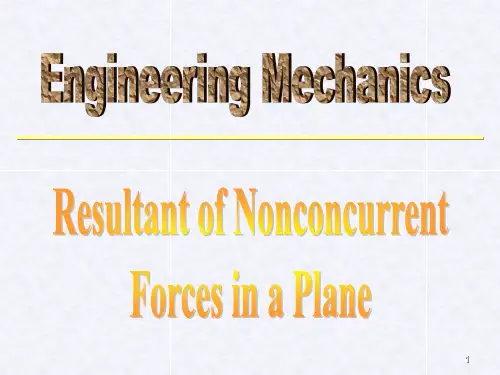
R' F' A F B C D O P'
M F AB OC F R, OA AB CD CD OC AB OA OC CD AB OA
18
R
P
OC M R CD R AB F AB M OA
A given couple may be moved about in its plane of action without changing its effect on a rigid body.
+
-
5
2. Transmissibility The force F acting on a rigid body has the properties of a sliding vector and can therefore act at any point along its line of action and still create the same moment about point O. This is the principle of transmissibility. It is important to realize that only the external effects, such as the body’s motion or the forces needed to support the body if it is stationary, remain unchanged after F is moved.
d F F F
13
d
F
The moment produced by a couple is called a couple moment. Its value can be determined by finding the sum of the moment of both couple forces about any arbitrary point.
专业英语工程力学
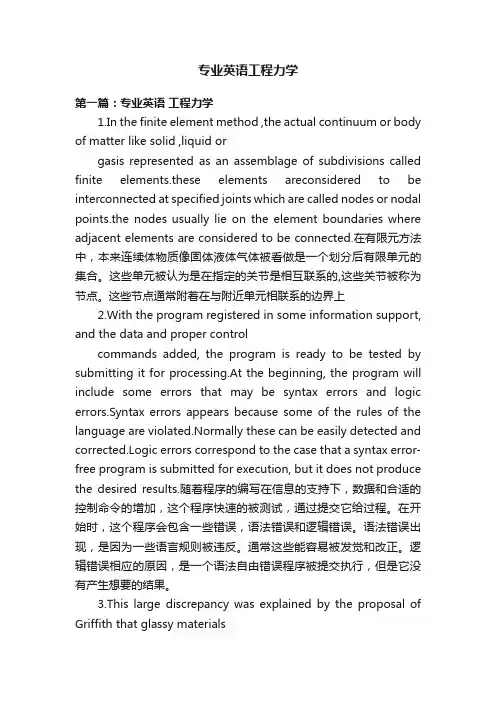
专业英语工程力学第一篇:专业英语工程力学1.In the finite element method ,the actual continuum or body of matter like solid ,liquid orgasis represented as an assemblage of subdivisions called finite elements.these elements areconsidered to be interconnected at specified joints which are called nodes or nodal points.the nodes usually lie on the element boundaries where adjacent elements are considered to be connected.在有限元方法中,本来连续体物质像固体液体气体被看做是一个划分后有限单元的集合。
这些单元被认为是在指定的关节是相互联系的,这些关节被称为节点。
这些节点通常附着在与附近单元相联系的边界上2.With the program registered in some information support, and the data and proper controlcommands added, the program is ready to be tested by submitting it for processing.At the beginning, the program will include some errors that may be syntax errors and logic errors.Syntax errors appears because some of the rules of the language are violated.Normally these can be easily detected and corrected.Logic errors correspond to the case that a syntax error-free program is submitted for execution, but it does not produce the desired results.随着程序的编写在信息的支持下,数据和合适的控制命令的增加,这个程序快速的被测试,通过提交它给过程。
工程力学双语chBasicConcepts
What is Mechanics?
1.1 Introduction
第4页/共19页
Mechanics is fully connected with our daily life…
Statics (静力学)Equilibrium(平衡)
1.1 Introduction
第5页/共19页
第14页/共19页
1.2-1.4 Units ant Conversion of it
Length1 in.=25.40mm1 in.=0.02540m1 ft.=0.3048mForce1 lb=4.448N1 kip=4.448kN
1mm=0.03937 in.1m=39.37 in.1m=3.281 ft1N=0.2248 lb1kN=0.2248kip
1.1 Introduction
第11页/共19页
Dose the shoe smell ok?
1.1 Introduction
第12页/共19页
1.1 Introduction
1. About Static. Static is the branch of mechanics which studies the laws of equilibrium of bodies under the action of force systems. It mainly studies simplifications and equilibrium conditions of force systems and applications of the corresponding results.2. About Strength/Mechanics of materials.3. About the study of this course.
工程力学全英文Engineering Mechanics (31)
Part II:Mechanics of MaterialsTorsionStudy object: A long straight member subjected to a torsional loading •How to determine the stress distribution?•How to determine the angle of twist?•Statically indeterminate analysis of the member in torsion?Torsion:If a member is subjected to the action of a pair of moments which are of a common magnitude and opposite senses,and lie in planes perpendicular to the longitudinal axis,the member is said to be in torsion.Screwdriver bar Transmission shaftTorque: a moment that tends to twist a member about its longitudinal axis. Shaft: a member that deforms mainly in torsion.Assumptions :•The cross section remains a plane,and the size and shape remain the same (a rigid plane).•The cross section rotates about the longitudinal axis through an angle.The small element on the surface is under pure shear:By observation :Longitudinal lines : remain straight , twisted angle;the length of shaft remains unchangedRadial lines : remain straight and rotate about the center of the cross sectionCircumferential lines : remain the same and rotate about the longitudinal axis TORSIONAL DFORMATION OF A CIRCULAR SHAFT t M tMAngle of twist : the relative angular displacement between two cross-sections,()x φ The angle of twist varies linearly with x .()x φφ∆The angle of twist of the back face: ()x φThe angle of twist of the front face: ()x φφ+∆causes the element to be subjected to a shear strain.Isolate an element from the shaft After deformation Before deformationIf andx dx ∆→d φφ∆→Since and are the same for all points on the cross section at x dφdxThe shear strain within the shaft varies linearly along any radial line from zero to .max γρd constant dx φ=at a specific position x c cdx d ///max γργφ==max γργ⎪⎭⎫ ⎝⎛=cImportant points (review)☐Assumptions:for a shaft with a circular cross section subjected to a torque.•The cross-section remains a plane•The length of the shaft and its radius remain unchanged•Its radial lines remain straight and circles remain circular☐The shear strain varies linearly along any radial line.r If the material is linear-elastic, then Hooke’s law applies, G τγ=A linear variation in shear strain leads to a corresponding linear variation in shear stress . The integral depends only on the geometry of the shaft.2max max A T dA J c c ττρ==⎰Polar moment of inertia max ()()A A T dA dA c ρρτρτ==⎰⎰Each element of area located at ,is subjected to aforce of .The resultant internal torque producedby this force is dA ρ()dT dA ρτ=()dF dA τ=TORSIONAL FORMULAmax γργ⎪⎭⎫ ⎝⎛=c max τρτ⎪⎭⎫ ⎝⎛=cT J ρτ=wheremaxτT :c :J :Torsional formulaPolar moment of inertia()cc A cd d dA J 0403022)41(222ρπρρπρπρρρ⎰⎰⎰====42c J π=Note: J is a geometric property of the circular area and is always positive. The commonunit is mm 4Solid shaft Tubular shaft ()4402i c c J -=πO 2cρρd d 2d =A O 2c i 2c 0ρρdThe internal torque T develops a linear distribution of shear stress along each radial line in the plane of the cross-section,it also develops an associated shear-stress distribution along an axial plane.Why?T Jρτ=The internal torque T develops a linear distribution of shear stress along each radial line in the plane of the cross-section,it also develops an associated shear-stress distribution along an axial plane.Why?(complementary property of shear stress))(x TAbsolute Maximum Torsional Stress of a shaft -A torque diagramThis diagram is a plot of the internal torque T versus its position x along the shaft length. Sign convention: By right-hand rule, if the thumb directs outward from the shaft, then the internal torque is positive.The Procedure of Analysis to determine the shear stress for a shaft under torsion1. Internal Loading (Torque)Section the shaft perpendicular to its axis at the point where the shear stress is to be e free-body diagram and the equilibrium equations to obtain the internal torque.2. Cross Section Properties (Polar moment of inertia )3. Shear Stress Distribution (Torsional formula)T J ρτ=42c J π=()4402i c c J -=πJTc =max τThe shaft is supported by two bearings and is subjected to three torques. Determine the shear stress developed at point A and B , located at section a-a of the shaft.Example 1ABInternal Torque.The bearing force reactions on the shaft are zero, since the applied torques satisfy moment equilibrium about the shaft’s axis.The free body diagram of the left segment.mkN T T m kN m kN M x ⋅==-⋅-⋅=1250030004250 ;0∑ABmkN T ⋅=1250AB Cross Sectional Property. The polar moment of inertia for the shaft is 474 )10(97.4) 75(2mm mm J ==πShear Stress. Since point A is at ρ=c = 75 mm and point B at ρ= 15 mmGPa mm kN mm mm m kN J Tc A 89.1/89.1)10(97.4)75)(1250(247==⋅==τGPa mmmm m kN J T B 377.0)10(97.4)15)(1250(47=⋅==ρτAns.Important points (review)☐For a linear elastic homogenous material, the shear stress along any radial line of the shaft varies linearly from zero to a maximum value at the outer surface.☐The shear stress is also linearly distributed along an adjacent axial plane of the shaft due to the complementary property of shear stress.☐Torsional formula:valid for a shaft with circular cross-section and made of homogenous material with a linear-elastic behavior.Deformation of the shaftdxd γφρ=(linear elastic material)d dxρφγ=)(/)(x J x T ρτ=Gx J x T )(/)(ργ=γτG =dxGx J x T d )()(=φANGLE OF TWISTdxGx J xT d )()(=φIntegrating over the entire length L of the shaft,⎰=Ldx Gx J x T 0)()(φTORSIONJGTL =φ∑=JGTL φConstant Torque and Cross-Sectional Area⎰=L dx Gx J x T 0)()(φ⎰=Ldx E x A x P 0)()(δAEPL =δ(Axially loaded bar)TTT 2T 1T 3Sign ConventionRight-hand rule,the torque and angle will be positive,provided the thumb is directed outward from the shaftTo determine the angle of twist of one end of a shaft with respect to the other end:1. Internal Loading (Torque)•The method of section and the equation of moment equilibrium2. Angle of Twist•The polar moment of inertia J (x );•or •A consistent sign convention for the shaftGdx x J x T )(/)(⎰=φJG TL /=φ✓If the torque varies continuously along the shaft’s length, a section should be made at the arbitrary position, T (x )✓If several constant external torques exist, the internal torques in each segment between any two external torques much be determined (a torque diagram)The Procedure of AnalysisExample 2The two solid steel shafts shown are coupled together using the meshed gears. Determine the angle of twist of end A of the shaft AB when the torque T=45N·m is applied.G=80GPa.Shaft AB is free to rotate within bearing E and F,whereas shaft DC is fixed at D.Each shaft has a diameter of20mm.1. Internal Torque. F ree body diagrams of the shafts are shown in figures. Step 1:Solution300Nm 150.0m/45N m 150.0/,0m 150.00=⋅===⨯-→=∑T F F T MABx ()()mN 5.22m 075.0N 003m 075.0,0-m 075.00⋅=⨯=⨯==⨯=F T T F Mx D x D CDx ∑→2. Angle of Twist.To solve the problem, we need to calculate the rotation of gear C with respect to the fixed end D in shaft DC .rad 0269.0]N/m )10(80[)m 010.0)(2/()m 5.1)(m N 5.22(294/+=⋅+==πφJG TL DC DC Since the two gears are in mesh, of gear C causes gear B to rotate C φBφrad0134.0 )m 075.0)(rad 0269.0()m 15.0(=→=B B φφm 010.0=c GPa80=GThen we need to determine the angle of twist of end A with respect to end B of shaft AB .The rotation of end A is therefore determined by adding and since bothangles are in the same direction .B φB A /φrad0.0850 rad 0.0716rad 0134.0/+=+=+=B B A A φφφAns.m 010.0=c GPa 80=G rad0134.0 =B φHomework assignments: 5-3, 5-9, 5-27, 5-38,5-58, 5-71()()()()()[]rad 0716.0m/N 1080m 010.02/m 2m N 45294/=⋅+==πϕJG TL AB BAEquilibrium:;0=--=∑B A xT T T MThere are two unknowns, therefore this problem is indeterminate.Compatibility or the kinematic condition: two ends are fixed:/=B A φSTATICALLY INDETERMINATE TORQUE-LOADED MEMBERS=-JGL T JG L T BC B AC A ()BC ACL LL +=⎪⎭⎫⎝⎛=L L T T BC A ⎪⎭⎫ ⎝⎛=L L T T AC B TORSION;0∑==B A xT T T M-- ;0=/BA φThe Procedure of AnalysisTo determine the unknown torques in statically indeterminate shafts:•Equilibrium equationsDraw a free-body diagram of the shaft to identify all internal torques.Write the equations of moment equilibrium about the axis of the shaft.•CompatibilityExpress the compatibility condition in terms of the rotational displacements caused by the reactive torques.•Solving unknownsSolve the equilibrium and compatibility equations for the unknown reactive torques.Pay attention to the sign of the results.Example 3The shaft is made from a steel tube,which is bonded to a brass core.A torque of T=250N·m is applied at its end,plot the shear-stress distribution along a radial line of its cross-section.(G st=80GPa,G br=36GPa)Solution:Equilibrium. A free-body diagram of the shaft . The reaction has been represented by twounknown amount of torques resisted by the steel, T st and by the brass, T br .m N 250=⋅+--br st T T Compatibility. The angles of twist at fixed end A should be the same for both the steel and brass since they are bonded together .brst φφφ==Applying the load-displacement relationship , , we haveJG TL /=φbrbr br st st st J G LT J G L T =brst T T 33.33=(1)(2)m N 28.7m N 72.242⋅=⋅=⇒br st T TThe shear stress in the brass core varies from zero at its center to the maximum at the interface, using the torsional formulaMPa 63.4mm)/2)(10(mm)mm/m)(10 m)(10N 28.7()(43max =⋅==πτbr br br J c T For the steel, the minimum shear stress is at this interfaceMPa 30.10])mm 10(mm) /2)[(20(mm) mm/m)(10 m)(10N 72.242()(443min=-⋅==πτst inner st st J c T The maximum shear stress is at the outer surfaceMPa 630.20])mm 10(mm) /2)[(20(mm)mm/m)(20 m)(10N 72.242()(443max =-⋅==πτst outer st st J c Tm N 28.7mN 72.242⋅=⋅=br st T Trad )10(1286.0N/mm)10(36N/mm 63.43232-===G τγAns.Homework assignments: 5-75, 5-82, 5-85The shear stress is discontinuous at the interface because the materials have different moduli .The stiffer material (steel)carries more shear stress.However,the shear strain is continuous at the interface.Shear strain at the interface:MPa63.4)(max =br τMPa30.10)(min =st τMPa630.20)(max =st τ。
工程力学常见专业英语词汇总结
空间变量spatial variations
直径diameter
半径radius
必要条件prerequisite
充分条件sufficient condition
质量守恒conservation of mass
动量守恒conservation of momentum
静定问题statically determinate problems
超静定问题statically indeterminate problem
轴向荷载axial load
均布荷载uniform distribution load
集中荷载concentrated load
冲击荷载shock loading
机械能守恒conservation of mechanical energy
能量守恒conservation of energy
守恒定律law of conservation
摩擦friction
内摩擦角friction angle
水平面horizontal plane
假想平面imaginary plane
相互垂直平面mutually perpendicular planes
平面外法向outward normal to the plane
前言preface
后记postscript
附录appendix
连续介质continuousmedium
非连续介质discontinuous medium
周围介质surroundingmedium
气体静力学aerostatics
气体动力学aerodynamics
变形量the amount of deformation
工程力学专业英语_词汇
1.Energy Release Rate: 能量释放率2.Brittle Material: 脆性材料3.Strain Energy: 应变能4.Ductile Matetrial 韧性材料5.Strength Criterion: 强度判据/强度准则6.Crack tip 裂纹顶端7.Homogeneous 各向同性8.Principle of Virtual Work: 虚功原理9.Time-Dependent Deformation: 时间相关变形10.Fatigue in Metals: 金属的疲劳11.damage and Fracture 损伤与断裂12 . stress concentration .应力集中13. crack propagation 裂纹传播14.stress intensity factor 应力强度因子15.brittle fracture 脆性断裂16.ductile fracture 韧性断裂17.Fatigue life 疲劳寿命18.creep deformation 蠕变变形19.plastic deformation 塑性变形20.constitutive relationship 本构关系31. longitudinal 纵向32. transverse 横向33. horizontal 水平的34 . resistance 抵抗力35. ultimate 终极的36. isotropic 各向同性37. deviatoric 偏量的38. assumption 假设39. bind 结合40. blunt 钝的41 FRACTURE TOUGHNESS 断裂韧性42 POLYCRYSTALLINE MATERIALS 多晶体材料43 Single Crystalline materials 单晶体材料43 AMORPHOUS MATERIALS 非晶态材料44 CRYSTAL STRUCTURE 晶体结构45 Linear Elastic Fracture Mechanics 线弹性断裂力学46 theory of elasticity 弹性理论47 homogeneous state of stress 均匀应力状态48 stress invariant 应力不变量49 strain invariant 应变不变量50 strain ellipsoid 应变椭球51 homogeneous state of strain 均匀应变状态52 equation of strain compatibility 应变协调方程accumulated damage累积损伤brittle damage脆性损伤ductile damage延性损伤macroscopic damage宏观损伤microscopic damage细观损伤microscopic damage微观损伤damage criterion损伤准则damage evolution equation损伤演化方程damage softening损伤软化damage strengthening损伤强化damage tensor损伤张量damage thresh old损伤阈值damage variable损伤变量damage vector损伤矢量damage zone损伤区Fatigue疲劳low cycle fatigue低周疲劳stress fatigue应力疲劳random fatigue随机疲劳creep fatigue蠕变疲劳corrosion fatigue腐蚀疲劳fatigue damage疲劳损伤fatigue failure疲劳失效fatigue fracture疲劳断裂fatigue crack疲劳裂纹fatigue life疲劳寿命fatigue rupture疲劳破坏fatigue strength疲劳强度fatigue striations疲劳辉纹fatigue threshold疲劳阈值alternating load交变载荷alternating stress交变应力stress amplitude应力幅值strain fatigue应变疲劳stress cycle应力循环stress ratio应力比safe life安全寿命overloading effect过载效应cyclic hardening循环硬化cyclic softening循环软化environmental effect环境效应crack gage裂纹片crack growth, crack Propagation裂纹扩展crack initiation裂纹萌生。
- 1、下载文档前请自行甄别文档内容的完整性,平台不提供额外的编辑、内容补充、找答案等附加服务。
- 2、"仅部分预览"的文档,不可在线预览部分如存在完整性等问题,可反馈申请退款(可完整预览的文档不适用该条件!)。
- 3、如文档侵犯您的权益,请联系客服反馈,我们会尽快为您处理(人工客服工作时间:9:00-18:30)。
"Engineering Mechanics B"I. Statics part1, three engineering mechanics used in analysis:1) Mechanical Analysis: Solid in the external force, either in whole or in which any part of the body as well as a unit, must meet the dynamic equations (Newton's second law).When an object is in constant motion or stationary, it must satisfy the equilibrium equations. 2) Geometric Analysis: To displacement and deformation (strain) is a solid force. There should be some relationship between displacement and strain. Adjacent solid objects (including bearings, etc.) in contact, on the boundary will be bound by certain geometric or kinematic properties.3) the relationship between physical properties: physical sexual relations: relations deformation and external forces, usually expressed as a stress-strain relationship.Such relationships associated with the material itself is sometimes called constitutive relations materials.Generalized Hooke's law is the relationship between the physical properties of a linear elastic, consider these three aspects can constitute three equations, namely mechanical equations, geometric equations, physical equations, and the necessary boundary conditions.2, plane force system simplification: principal vector. Main clause :( algebra and)3, co-moment theorem:Force equal to that of each component of the moment of moments to change the point of algebra and.4, three of the Concurrent: the role of the three forces on the same object if the balance, the three forces (or Fangxiang Yan long) post and point.Objects stress analysis: concentration, distribution force (uniform and non-uniform)Linear distribution q, surface distribution of p, body distribution5, two force components: Only two forces (trusses are two force members), and other large, reverse, acting on the two connections.Couple: Fd (couple only force even balance).6, plane forces in equilibrium conditions:AndA moment formula:; two moments formula: X axis and A,B torque balanceThree moments of the formula: The A, B, C :( three moments moments from three points wherein A, B, C three o'clock not collinear)Second, the material mechanics section(One)A relationship between internal forces and bending differential between;; distributed load qTwo shear Q, bending moment M relationship between figure and force:a) within a period of no beam load, shear Pictured a horizontal line, a moment Pictured oblique line.b) within a certain period of load beam uniformity role in an oblique shear Pictured straight Pictured moment a parabola.c) a cross section of the beam. , Zero shear, moment there is a maximum or minimum.d) on the left and right, shear force Q by centralized there is a sudden change in cross-section, theslope of the bending moment diagram is also a turning point for the formation of an abrupt change Three combined deformation: torsion and bending combination (a) external to the rod cross-section centroid simplify (2) to determine the risk of internal force diagram drawing section(3) to determine the danger point and build strength conditions4 Press the third strength theory, strength conditions: Or, for a round shaft,, its strength conditions:.(B) the tension and compressionA plane hypothesis: the deformation of the front cross-sectional plane after deformation remains flat:Stress on the oblique section 2:3, axial tension or compression strength calculation: maximum normal stress4, three types of calculation:1) strength check rod known Nmax, A, [σ], strength checking component meets the conditions2) Design section: Known Nmax, [σ], depending on the intensity condition, seeking A3) determine the permissible load: Known A, [σ], depending on the intensity condition, seeking Nmax5, the axial tensile deformation and Hooke's law when: longitudinal strain transverse strainPortrait Landscape, μis called lateral deformation coefficient or Poisson (Poisson) ratio6, (experimental)Mild steel tensile test: the proportional limit σp yield limit σs ultimate strength σbWhere σs and σb is an important indicator to measure the strength of the material.(C) reverse1, the curvature of the neutral layer formula2, the normal stress formula:3, tensile and compressive deformation energy:4, thin cylinder torque demand5, cut Hooke's lawShear modulus GMaterial constants: tension and compression modulus EPoisson's ratio μ6, torsional shear force:7, the polar moment of inertia:Hollow circle polar moment of inertia:Solid circles torsional section modulusHollow circle anti-torque modulus:8, a circular shaft torsion angle:9, stiffness conditions:(Intensity conditions:)Oblique section of stress:10, and other straight rod torsion strain energy:(Four) bending1, the sign of the provisions of the shear Q: upper left lower right is positiveSymbol prescribed bending moment M: Pull the pressure (on the concave or convex) is positive 2, (1) the degree of load sets, shear and bending moment differential relations:(2) Set the integral relationship between the degree of load, shear and bending moment(1)(2)3, the neutral axis through the centroid of the cross-section:Pure bending beam cross section normal stress:Curvature of the neutral layer of the formula:Bending beam intensity conditions of normal stress4, shear stress :( non-rectangular cross-section beam focus)5, I-section beam shear stress: On the web:6, circular cross-section beam shear stressFlexural strength shear stress conditions7, deflection and rotation states: upward deflection angle is positive counterclockwise positive The curve y = f (x) of curvature of8, with the integration requirements deformed beamsWhere integration constant C, D are determined by the boundary conditions and continuity conditions9, stiffness BeamStiffness conditions: [v], [θ] is permissible deflection and rotation components, they decided to component normal10, require at work.11, deformation of the beam is calculated using superpositionCan be calculated separately for each deformation under load alone, then superimposed.Factors affecting the beam bending load cases and only with the support beams, but also on the material of the beam, cross-sectional size, shape and span beams relevant. Therefore, in order to improve the bending stiffness, it should start with these various factors.(1) increasing the beam flexural rigidity EI(2) the support is reduced or increased span(3) changes in loading and seat location(Five) stress analysis strength theory1, three-dimensional stress state conditions:In parallel to the plane of σ1 σ2 and σ3 direction angle of 45 °on the role τmax2, the rod3, generalized Hooke's law:4, the tensile deformation energy5, the intensity of the theory:1) the maximum tensile stress theory (first strength theory)2) The maximum elongation of wire strain theory (second strength theory)3) the maximum shear stress theory (third strength theory)4) The fourth strength conditions:Four intensity condition unified strength theory can be written in the form:Called fairly stress6, the normal stress and shear stress on any slope:In parallel to the plane of σ1 σ2 and σ3 direction angle of 45 °on the role τmax(Six) lever stability1, Euler's formula hinged at both ends of slender columns critical pressureOther constraints rod ends slender columns under critical pressure:The critical stress bar:Flexibility is defined to calculate the critical stress bar Euler's formula2, Euler formula Scope:。
